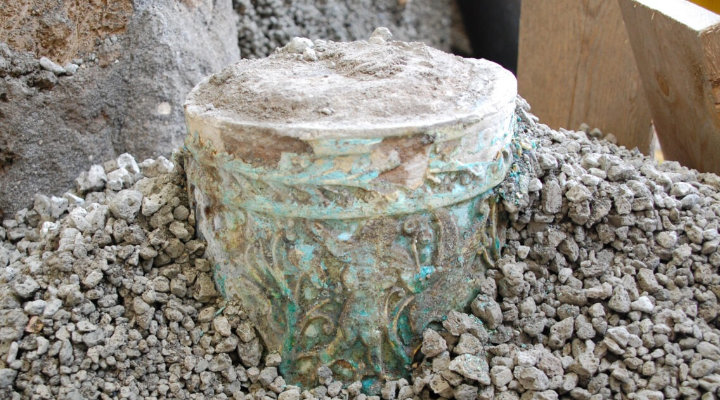
During recent stabilization and conservation work at the famed Thermopolium in Regio V, an intriguing detail came to light: at the center of the service kitchen stood a refined glass-paste situla made in Alexandria, Egypt, decorated with hunting scenes in a Nilotic style. An object usually found in Vesuvian contexts as a high-status garden or reception ornament was, in this case, repurposed as a practical kitchen container. Ongoing analyses may even reveal traces of its original contents.
What the latest excavations revealed
Work launched in 2023 around the Thermopolium has brought to light the ground-floor service rooms and a small apartment on the upper floor, likely inhabited by the shopkeepers. In the room with the cooking hearth, tools used to prepare food—mortars, pans—were found still in place, together with numerous wine amphorae from across the Mediterranean, attesting to a wide and dynamic network of exchange.
A crossroads of objects, styles, and ideas
According to Director Gabriel Zuchtriegel, furnishing both the kitchen and the household shrine with “exotic” objects shows how permeable the Roman world was to tastes, visual languages, and likely religious ideas from the East. Strikingly, this circulation did not concern elites alone: even the back room of a popina—a street-food venue—helped spread cultural and religious fashions, from Egyptian cults and, later on, Christianity.
A well-organized service area
At the time of the eruption in 79 CE, the room next to the Thermopolium’s counter functioned as a service space organized for efficiency: a small bathroom opened onto the so-called Vicolo dei Balconi; one area was set aside for storing amphorae and other liquid containers; the remaining space held tools and materials for processing, cooking, and preserving food. Among the most noteworthy finds is the richly decorated faience situla mentioned above, a tangible sign of Pompeii’s commercial and cultural vitality.
Upstairs: modest yet refined rooms
Above the service rooms were two small chambers. One, in particular, was frescoed in Fourth Style with illusionistic architectural motifs and had a yellow floor. The furnishings likely included pieces of furniture—some perhaps faced with polychrome marble panels—and personal belongings kept in richly adorned wooden caskets.
Preserving and enhancing
The extraordinary maintenance project also restored wall structures and decorative schemes known from earlier interventions, with the aim of protecting and making them legible. Removable protective roofs, designed to blend harmoniously with the archaeological setting, now shield rooms and finds from the elements, while new lighting will highlight details and atmospheres, improving the visitor experience.


